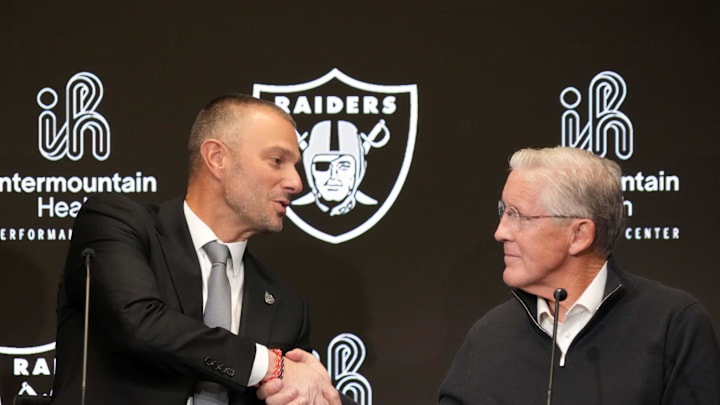The Raiders’ practice field in Henderson, Nevada, has always been loud — but not like this. Gone are the sterile commands and Belichickian silence that once defined drills under the “Patriots West” era. Now, music thunders through the speakers — a mix of old-school grunge, hip-hop, and hard rock — and the air feels looser, louder, alive.

At midfield, head coach Antonio Pierce watches with folded arms as players bark encouragement. “Faster!” he yells, then laughs when rookie cornerback Jakorian Bennett shoves a teammate after a broken-up pass. It’s organized chaos — part intensity, part joy.
This is not New England in the desert anymore.
These are the Seattle Raiders — or as one assistant joked recently, “Seattle South.”
Because what’s happening inside this building isn’t just another midseason tweak; it’s a philosophical migration — away from the rigid, rule-heavy culture imported by Josh McDaniels, and toward something freer, more emotional, more Pete Carroll-esque.
The question now is whether that shift, equal parts psychological and strategic, can rescue their season.
The Aftermath of “Patriots West”
When owner Mark Davis hired McDaniels and general manager Dave Ziegler in early 2022, the idea was simple: import the Patriot Way. Bring discipline. Bring consistency. Bring rings by proxy.

Instead, the experiment crumbled under its own weight. The atmosphere became tense, the locker room fractured, and players — particularly veterans like Davante Adams and Maxx Crosby — felt their voices fading beneath layers of hierarchy.
“It wasn’t fun,” one player admitted. “You came to work. You did your job. But it didn’t feel like football.”
By midseason last year, the whispers had grown into rebellion. The loss to Detroit on Monday Night Football became the breaking point. Within 48 hours, McDaniels was gone, Ziegler was gone, and linebackers coach Antonio Pierce — a former Giants captain known for emotional leadership — was suddenly in charge.
His first move wasn’t tactical. It was cultural. He brought back music, loosened curfews, invited families to the facility, and told players to “play like they love this game again.”
The locker room erupted in relief. The team responded with wins.
But as the new season unfolded, it became clear that the Raiders weren’t just leaving New England’s shadow — they were stepping into another one: Seattle’s.
Why “Seattle South”?
Pierce never worked under Pete Carroll, but their philosophies echo. Both are former linebackers who value energy over ego and connection over control. Both believe in what Carroll calls “relationship-based coaching” — knowing your players deeply so you can demand more from them.
“Antonio’s a motivator,” said one assistant who previously coached in Seattle. “He coaches with his eyes and his heart. That’s pure Carroll.”
Evidence of the Seahawks’ imprint is everywhere:
-
Music at practice (a Carroll staple).
-
Open communication — players are encouraged to question coaches, not fear them.
-
Competition Wednesdays — Pierce’s version of Carroll’s “Always Compete” mantra.
-
Even the defensive terminology now borrows concepts from the old Legion of Boom playbook — hybrid cover-3 shells, interchangeable safeties, physical press coverage.

It’s no coincidence that Pierce brought in several assistants with Pacific Northwest ties. Linebackers coach Ken Norton Jr., a Carroll disciple, returned to help mold leadership culture. Defensive analyst Kris Richard, who helped build the Legion of Boom, was quietly added as a consultant.
“Pete’s whole thing is belief,” Richard said. “If you don’t believe, you can’t build. I think Antonio gets that.”
The Players’ Perspective: Freedom and Fire
For the players, the difference between the old regime and the new one feels like day and night.
Under McDaniels, practices were rigid — scripts timed to the second, mistakes corrected mid-play, creativity frowned upon. Under Pierce, the energy feels improvisational, organic, competitive.
“You can breathe again,” said wideout Jakobi Meyers, who ironically followed McDaniels from New England but has flourished under Pierce. “It’s still disciplined, but it’s human.”
Edge rusher Maxx Crosby — the team’s emotional engine — has emerged as the spiritual bridge between the two worlds. His relentless motor fits both the Patriots’ work ethic and the Seahawks’ passion. But even he admits: “Man, it feels different now. There’s love in the building.”
Crosby and safety Tre’von Moehrig have spearheaded a defensive renaissance rooted in communication. “We talk more,” Moehrig said. “We trust more. It’s not robotic. It’s reaction and energy.”
That emotional openness — once seen as weakness in the Patriot model — has become the foundation of Pierce’s approach.
Inside the Scheme Shift
The transformation isn’t just cultural. It’s schematic.
Defensive coordinator Patrick Graham, once a Belichick protégé himself, has gradually retooled the defense to mirror Seattle’s 2013–2016 identity — aggressive zones disguised as man coverage, interchangeable safeties, and physical corners pressing the boundary.
The team studied old Legion of Boom tape this offseason. They even ran drills named after former Seahawks legends — “Kam’s Strike,” “Sherm’s Wall,” “Earl’s Angle.”
“It’s not about copying,” Graham clarified. “It’s about philosophy — closing space, controlling tempo, playing free but smart.”
Statistically, the results are emerging:
-
The Raiders rank top-10 in red-zone defense and yards per play allowed since Week 5.
-
Opposing quarterbacks have a passer rating of under 85 when throwing outside the numbers — a hallmark of Seattle’s cover-3 philosophy.
Offensively, Pierce has given coordinator Luke Getsy (also with past Car





